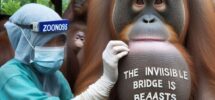The trees hum with life—birds, insects, monkeys swinging from one branch to another. This is not just a jungle; it’s a living library, full of secrets and ancient viruses. Among the inhabitants are chimpanzees and sooty mangabey monkeys, carriers of a virus that would one day leap a species barrier and change human history. This leap is called zoonosis, and it is the answer to the question: Where did AIDS come from?

The Viral Jump: From Monkeys to Humans
To understand where AIDS came from, we must first meet its predecessor: SIV, or Simian Immunodeficiency Virus. Unlike humans, most of these monkeys live peacefully with the virus, showing little to no symptoms. But when humans came into contact with these animals—especially through bushmeat hunting and handling—they were exposed to SIV-infected blood.
This repeated exposure eventually led to a mutation of SIV into HIV (Human Immunodeficiency Virus). Scientists believe that this transformation most likely occurred when a hunter sustained cuts or open wounds while butchering a chimpanzee or monkey. Through a slow and silent process, the virus adapted to its new human host.
Just like a key reshaped to fit a different lock, SIV evolved inside the human body until it unlocked a devastating new path—HIV.
The First Human Cases
So where did AIDS come from in terms of geography and time? The earliest known human infection is believed to have occurred in the Democratic Republic of Congo, possibly as early as the 1920s. But by then, the virus had likely already spread through river routes, trade networks, and growing cities.
At first, HIV traveled quietly. Its symptoms mimic other diseases, and it can remain dormant for years before progressing to AIDS (Acquired Immunodeficiency Syndrome). This made it nearly invisible to early 20th-century medicine.

Urbanization: The Virus Finds Highways
Kinshasa, a bustling hub even in the early 1900s, played a key role in the early spread. As people moved into cities for work and trade, so did HIV. Colonial rule brought railways, new healthcare systems (often involving needle reuse), and increased mobility—factors that unknowingly accelerated transmission.
It’s like pouring gasoline on a spark. The virus, once isolated in remote forests, now had the perfect vehicle to grow into a global epidemic.
The Global Discovery: 1981 and Beyond
The world officially took notice in 1981, when clusters of unusual illnesses began appearing among young men in the United States. These mysterious infections were later understood to be the result of a collapsing immune system—AIDS. From that point, scientists worked backward to trace the origins of the virus, uncovering its long journey from primates to people.
Through advanced genetic analysis, researchers confirmed that HIV-1, the most common and deadly form, originated from chimpanzees, while HIV-2, a milder form, came from sooty mangabey monkeys.
The Lesson of the Rainforest
The tale of where AIDS came from is not just about a virus. It’s a vivid reminder that what happens in a remote rainforest can ripple across continents.
In the end, AIDS didn’t arrive out of nowhere. It emerged from a chain of small, often invisible events—one hunter’s cut, one reused needle, one crowded city. Tracing its origin teaches us not only about the virus but about the human condition itself: our curiosity, our mistakes, and our deep link to the natural world.
By understanding its origin, we arm ourselves not just with knowledge, but with the wisdom to prevent future pandemics.


